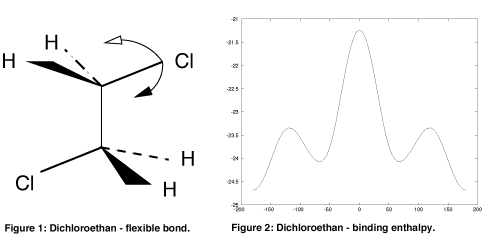
ERCIM News No.44 - January 2001 [contents]

![]()
ERCIM News No.44 - January 2001 [contents]
by Ales Krenek and Ludek Matyska
In 1998, a complex research project on human-computer interaction was started at the Masaryk university. One of its major streams focused on the development of new methods for efficient examination and extraction of principal features from large data sets produced by chemical computations. These methods are based on the interaction via haptic interface.
Many interesting chemical properties are function of force, which is usually understood to be a space gradient of potential energy. Visualization techniques represent force via 2D or 3D diagrams enhanced by use of colour, ie, user must translate visual phenomena to her internal force representation. The use of haptic interface opens a completely new dimension, when force (as potential gradient) can be represented and felt directly, without any unnatural transformation. Moreover, our physical experience makes it easy to mentally integrate the force, keeping a notion of the overall energy of the system as a consequence.
The idea is currently explored on computational results of a heuristic systematic search through conformational space of flexible biomolecules. Used method of the heuristic search was also developed at Masaryk University, where computational chemistry belongs among its well established research areas. The method was implemented as a production software package, currently consuming about 30% computational resources of the University’s supercomputing center. Numerous papers were published on the method itself and results achieved.
Let’s demonstrate the principle on a simple example of the dichloroethan (see Figure 1). The molecule is flexible, ie, its top part can rotate relatively to the bottom one along the vertical axis. The binding enthalpy (ie, a measurable and computable quantity corresponding, more or less, to internal energy) depends on the angle of rotation, as shown in Figure 2. The difficulty to overcome the rotational barrier can be directly related to the force necessary to move a point along the curve in the figure.

The principal goal of this research is design of a haptic interface that allows the user to modify shape of a molecular model (eg, to rotate a particular bond) while ‘feeling’ the required energy via force resistance. In the example above the user can twist the model feeling resistance when the atoms get aligned vertically, maximal force corresponds to perfect alignment of the chlorine atoms.
A prototype application we presented recently builds a van der Waals surface of the modeled molecule and lets the user manipulate a spherical probe of about hydrogen size. The probe can touch the surface and deform the model by rotating the flexible angles if appropriate force is delivered. This haptic interface is accompanied with 3D visualization of the process.
The implementation uses PHANToM force feedback device manufactured by Sensable, Inc. The application is distributed, runs in UNIX environment, using PHANToM Linux driver also developed at our site.
Driving a haptic device requires fast computation of the model - in order to create illusion of smooth surfaces etc., the force has to be recomputed at the rate 1—3 kHz. However, a convincing dynamic molecular model requires energy minimalisation in each step. In general, such calculation cannot be done in the available time (300 us - 1 ms).
The current implementation therefore performs the energy minimalisation at much slower rate (typically once per several seconds) and interpolates among the results. The energy model is also restricted to narrow neighbourhood of local energy minima in order to further reduce otherwise impossibly high requirements on computational resources.
In future we plan to extend our research activity in the following ways:
To conclude, we introduced a general concept of delivering information on energy of a molecular model (as function of force) via haptic interface. We built a prototype application that supports the concept. However, as the science behind haptic interfaces is very premature, a lot of effort is still needed to fulfill the primary expectation, ie, to provide an effective interface to huge data sets emerging from scientific calculation.
Please contact:
Ales Kenek - CRCIM (Masaryk University)
Tel: +420 5 4151 2258
E-mail: ljocha@ics.muni.cz